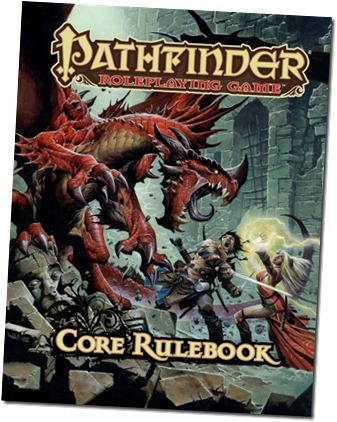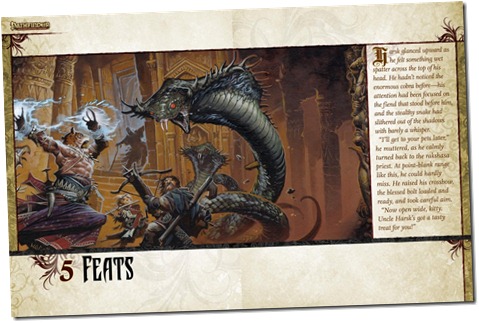The Pathfinder Roleplaying Game has been out for a while, since August 2009, and it’s made me a happy gamer so far! So if you want the short of it there you have it. Interested in a little more detail? Ok read on…
 Many people have reviewed the game and I don’t intend to rehash that here. I’ll give you my experience with the game over the last 32 sessions of my weekly campaign. We actually began playing with the Beta Test rules. The publisher, Paizo, carried out a lengthy play test listening to player feedback and fine tuning the game to the likes of the community. Like any endeavor by committee not everybody involved was pleased with the result, but I think the game is better for it.
Many people have reviewed the game and I don’t intend to rehash that here. I’ll give you my experience with the game over the last 32 sessions of my weekly campaign. We actually began playing with the Beta Test rules. The publisher, Paizo, carried out a lengthy play test listening to player feedback and fine tuning the game to the likes of the community. Like any endeavor by committee not everybody involved was pleased with the result, but I think the game is better for it.
In case you’ve lived under a rock for the last couple of years, the Pathfinder RPG carries on the proverbial torch for D&D 3.5. While Wizards of the Coast published a new edition of D&D, Paizo attempted to improve on the existing edition. Pathfinder is still a d20 game, close in form and methods to its roots. The complexity and detail in D&D 3.5 are still there and one of the stated design goals was backwards compatibility with older material, making converting material from D&D 3.5 to Pathfinder relatively easy. There is even a Conversion Guide!
What they have improved on are the fiddly bits in the system, details that made some aspects of the game difficult, needless complexities and attempted to “balance” classes. Let me give you some specific examples:
Calculating Skill ranks has been greatly simplified; no more half ranks and the tedium of skill selection when creating a character above 1st level, and forget if this was a multiclassed character! Now you simply put your ranks in skills, if it’s a Class Skill you get +3, no more fuss! There are also no pesky multiclassing penalties, instead characters a pick favored classes and get small bonuses when they select levels in that class. Some skills have been condensed into broader categories and Feat options are expanded and varied.
The classes have been cleaned up, every class has something to offer at every level, and every class has a special ability at 20th level to entice players to stick to one class all the way through. They tried to reign in spell casters, a common complaint in D&D 3.5, by boosting other classes and modifying magic to bring it more to par with other abilities. So there is definitely a power creep in all classes and races which bring them to levels comparable to classes published in later D&D 3.5 books, but I’d be careful when adapting those to a Pathfinder game some might be pretty straightforward, others might require more work, but fans have done a great work of this in the Paizo Forums, so search there for your favorites.
Save or Die spells are a thing of the past, spell casting in combat is much harder, now simply a Caster Level check (rolling against a difficulty and simply adding your level in the spell casting class) which has been the hardest pill to swallow for my players who like to play spell casters. Most combat maneuvers like grappling or disarming that had different rules for each specific instance have been folded into a unified Combat Maneuver mechanic that is easy to follow and makes sense. Creating magic items no longer requires the expenditure of XP and the new costs for creating magic items has worked well so far in my game.
On the Game Master’s side encounters are now created using an experience point budget and it’s easier to build them quickly and include more opponent variety in the mix. Likewise assigning treasure has been simplified and creating and equipping simple NPCs has also been made simpler. Key NPCs still require a little more work, but the run of the mill opponents can be created with ease. Prep time for Game Masters is reduced, it still require some time, but far less than before. There are three different experience tables for those of us that thought characters just went up in level too quickly.
 The book is massive, 575 pages big, and combines all the rules for Players and Game Masters. Beautifully illustrated, there is some of the fantasy-punk art some people hated during the D&D 3rd edition phase, but I an not bothered by it so be aware. The book has some mistakes and the inevitable errata is available for the 1st printing (the copy I own) but nothing that makes the book unusable.
The book is massive, 575 pages big, and combines all the rules for Players and Game Masters. Beautifully illustrated, there is some of the fantasy-punk art some people hated during the D&D 3rd edition phase, but I an not bothered by it so be aware. The book has some mistakes and the inevitable errata is available for the 1st printing (the copy I own) but nothing that makes the book unusable.
If you liked D&D 3.5 but had some problems with certain issues this game may be for you. If you are a fan of D&D 3.5 and want to see what can be done to improve it, you owe it to yourself to give this game a try. If you want a rules-light game this is definitely not for you. I don’t think this is a game that new players will be able to pick of the shelf and play without some help, it’s not a gateway game, but with help from someone with experience in the game it can be whole lot of fun. I’m actually going to run a demo game for the system this Sunday for players who have not tried it out and some players who have no idea what an RPG is!
The game is OGL and the folk at Paizo have provided a System Reference Document for the game, and the game is available in PDF format for $10 so you can try it out at a reasonable price. The rules for monsters are in their own book, the Pathfinder Bestiary, and while you could play with the older monster books, the reworked monsters are closer to the power level presented in the Pathfinder RPG rulebook. There are also many great third party products available for Pathfinder so it’s a good time to be a Pathfinder fan. I am confident this system can survive alongside D&D 4th edition and cater to those of us who did not find the new edition to our liking.
My campaign is still on relatively low levels, 6th and 7th, so I have not experienced higher level play, one particularly troublesome area of D&D 3.5 where combat typically dragged on, and one round took forever. So if there is any interest out there I will revisit this topic in a couple of months when my players have reached mid levels.
Thank your for reading and have a great weekend!

Fantastic review. I've been considering Pathfinder for a while, though I'm a big fan of 4e. I'm glad to hear you've been having such a good time of it. I may have to pick up a copy… Hmm…
Ever since I bought my own copy of the core rulebook, I think somewhere in October last year, it's still in its wrapper till today. *stares at bookshelf with unopened Pathfinder*
.-= Questing GM´s last blog ..Questing's Readings – 22/11/09 =-.
I do like some of the changes they've made to 3.x and have been meaning to try it out but ever since I bought my core rulebook (around October of last year) it's still in its wrapper until today.
*stares at unopen core rulebook sitting on bookshelf*
.-= Questing GM´s last blog ..Questing's Readings – 22/11/09 =-.
A friend gave me Pathfinder last September and man it's such a nicely done book. The Bestiary has really sold me on trying to start a campaign, the most complete 'monster manual' I've read so far. Also for your dollar the two books is packed with more content then I've seen in any other game.
Thank you all for your kind words…
Mark, like Mike said in his reply you get a lot for your buck! The Pathfinder RPG (and the Bestiary for that matter) are packed full of gaming goodness. If you own D&D 3.5 it may look similar but there are lots of small details.
If you are a fan of D&D 4the edition, be aware that this plays and feels like D&D 3.5 with some of the complications eliminated, but just some. It is STILL a system for people who like combat a little more complex and where the monsters and the characters are built following the same (well at least similar) rules.
Bu I encourage you and Questing DM and everybody out there to try the Pathfinder RPG, this an many of Paizo’s products are top notch and remind me of (what to me) was the golden time of the late 80’s early 90’s TSR games and campaigns.
To see the Pathfinder core books circulating on the libraries bookshelves here in Puerto Rico is a relief.
On the great tradition of OD&D ,1E,2E and 3E Pathfinder have done us D&D hardcore fans a great service.
Att
Akeron
Softcombat Games Puerto Rico Inc.
Akeron! So good to see you here… Yes I can attest that Pathfinder is moving off the shelves here in stores as well as the big book chains.
Nice Review. I did one myself and am glad to see the things I noted resonated here. Cheers,
AoB
AoB, glad you liked it… Longtime friend and one of my regular players in the Pathfinder campaign had some disagreements with the review. Valid points really. He does not post on blogs (don’t know why really) but I may address that here either as a comment or a follow up post, not sure really. Again thank you!
Great work on the review!
.-= Zachary Houghton´s last blog ..On Failure =-.
Zachary, thanks! I will have a follow up to this in a few days about some points a friend of mine brought up after reading the post.
I especially liked that Paizo didn't just make some power adjustments and drop a few useless conditions like other revisions did, and instead made the game more versatile and interesting without making it boring. I am half the time tempted to require wizards to take a specialty school in Pathfinder(I don't, but it seems like a totally reasonable house rule), because they did such a good job making the intricacies of the system at that point minimal while making the class itself more interesting to play. It feels like everything that was changed was changed to what we all thought it needed to be in the first place but didn't know until Paizo showed us what it looked like.